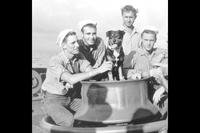In the early 1950s, American Jack Turner was captured in Cuba by government troops. He was caught smuggling weapons into the island nation. The regime of Fulgencio Batista, the U.S.-backed dictator of Cuba, tortured and killed Turner. His body was then fed to sharks. It was a fatal mistake for Batista.
Years later, his best friend, William Morgan, visited Cuba as a tourist but made his way to Fidel Castro's insurgent army in the jungles of the Sierra Maestra mountains. Morgan, a U.S. Army veteran, would become one of only two foreigners to join the Cuban Revolution and reach its highest rank, "Comandante."

Batista had been a longtime ally of the United States. During his first term as a democratically elected president, Cuba declared war on Japan two days after the attack on Pearl Harbor in 1941. After eight years out of the office and running for a second term in 1952, Batista led a coup against the elected leader and seized power. The Americans recognized his government just weeks later, but that didn't bring stability.
After World War II, Ohio-born William Alexander Morgan joined the U.S. Army and was sent to Japan with the 35th Infantry. He quickly divorced his wife and went AWOL. After escaping from Army custody by overpowering his guard, he was captured and court-martialed before receiving a dishonorable discharge in 1948.
Meanwhile, little changed in Cuba between the previous regime and the rise of Batista in 1952. Corruption was rampant, police brutality was widespread and the government cared little for providing education and medical services to Cubans. Enemies of the regime, like Turner, were summarily executed.
By November 1956, some Cubans had had enough of Batista. That year, a former lawyer named Fidel Castro was leading an amphibious landing from Mexico with just 81 men, including Argentinian Che Guevara. Almost as soon as the would-be revolutionaries landed, they were dispersed by Batista's troops. Forced to flee into the Sierra Maestra, their revolution almost ended before it ever began.
Yet, when Morgan came to Cuba in 1957, the island was filled with Castro's troops and agents. He met one of Castro's men in Florida before arranging to meet again in Havana, so Morgan could join the fight against Batista and avenge his friend's death. He told the rebels he was an Army veteran and would help train their troops.
Morgan's guerrilla unit was called the Second National Front of Escambray, after the mountain range in Cuba. He proved his worth (and that he wasn't a CIA operative) to the rebels, who eventually accepted him. The American trained the rebels in guerrilla warfare, judo and how to use explosives. He soon began to rise in rank, commanding miles of rebel-held territory.
Eventually, stories from the mountains began to spread across the island, stories of an American fighting alongside the Cuban rebels, killing hundreds of Batista's soldiers. Batista troops were brutal to the Cuban countryside, burning villages and torturing citizens. Castro's revolutionaries were not yet declared communists, and anything was better than Batista.
"El Americano," as Morgan came to be known, was hailed a hero. In July 1958, he was promoted to comandante, the highest rank in the rebel army, commander of the Second National Front and Batista put a $20,000 bounty on his head. He honestly believed he was fighting for freedom for Cubans, and for a Western-style democracy, according to journalist Herbert Matthews, who covered Morgan’s exploits in Escambray.
By December 1958, a decade after leaving the U.S. Army, he began coordinating with Guevara's troops. As Guevara captured the Cuban city of Santa Clara on New Year's Day, Morgan and the Second Front had captured many villages, advancing within 160 miles of Havana.
Morgan was preparing an assault on Cienfuegos when he heard the news: Batista had fled Cuba and the rebels won. On Jan. 6, 1959, Morgan met Castro for the first time as Castro made his way to Havana. As the war was ending, Morgan married a fellow rebel, Olga Maria Rodriguez. After the war ended, he settled down and became a frog farmer, harvesting legs and skins for sale in the U.S.

The revolution did not end the way Morgan expected, however. Castro, in spite of everything Morgan believed during the fight against Batista, pulled Cuba into the sphere of communist countries under the influence of his brother, Raul, and Guevara. Morgan was accused of smuggling weapons and ammunition to Cuban counter-revolutionaries.
Morgan's friends had returned to Escambray, taking up arms once again against the Castro government, which increasingly leaned communist, but Comandante William Morgan swore he never aided them. For his efforts in the Cuban Revolution, he was executed against a wall in Cuba's La Cabaña prison in 1961 as Fidel and Raul Castro looked on.

-- Blake Stilwell can be reached at blake.stilwell@military.com. He can also be found on Twitter @blakestilwell or on Facebook.
Want to Learn More About Military Life?
Whether you're thinking of joining the military, looking for post-military careers or keeping up with military life and benefits, Military.com has you covered. Subscribe to Military.com to have military news, updates and resources delivered directly to your inbox.
















